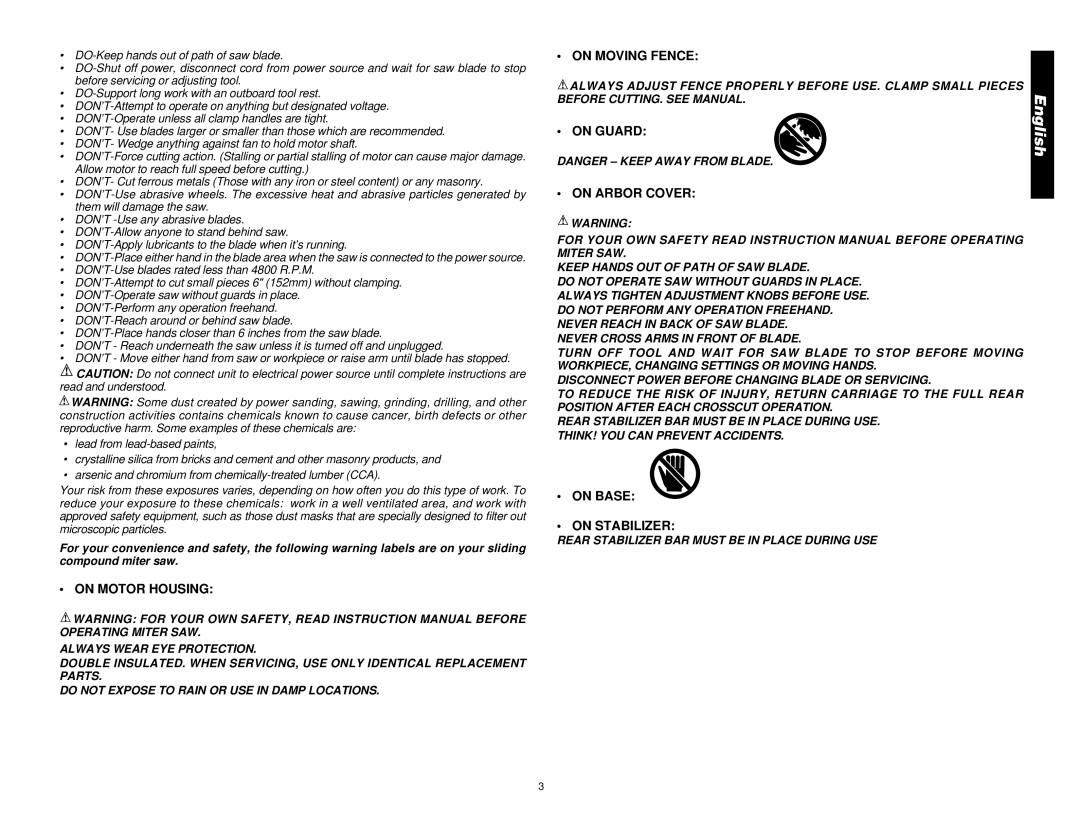
•
•
•
•
•
•DON’T- Use blades larger or smaller than those which are recommended.
•DON’T- Wedge anything against fan to hold motor shaft.
•
•DON’T- Cut ferrous metals (Those with any iron or steel content) or any masonry.
•
•DON’T
•
•
•
•
•
•
•
•
•
•DON’T - Reach underneath the saw unless it is turned off and unplugged.
•DON’T - Move either hand from saw or workpiece or raise arm until blade has stopped.
![]() CAUTION: Do not connect unit to electrical power source until complete instructions are read and understood.
CAUTION: Do not connect unit to electrical power source until complete instructions are read and understood.
![]() WARNING: Some dust created by power sanding, sawing, grinding, drilling, and other construction activities contains chemicals known to cause cancer, birth defects or other reproductive harm. Some examples of these chemicals are:
WARNING: Some dust created by power sanding, sawing, grinding, drilling, and other construction activities contains chemicals known to cause cancer, birth defects or other reproductive harm. Some examples of these chemicals are:
•lead from
•crystalline silica from bricks and cement and other masonry products, and
•arsenic and chromium from
Your risk from these exposures varies, depending on how often you do this type of work. To reduce your exposure to these chemicals: work in a well ventilated area, and work with approved safety equipment, such as those dust masks that are specially designed to filter out microscopic particles.
For your convenience and safety, the following warning labels are on your sliding compound miter saw.
• ON MOTOR HOUSING:
![]() WARNING: FOR YOUR OWN SAFETY, READ INSTRUCTION MANUAL BEFORE OPERATING MITER SAW.
WARNING: FOR YOUR OWN SAFETY, READ INSTRUCTION MANUAL BEFORE OPERATING MITER SAW.
ALWAYS WEAR EYE PROTECTION.
DOUBLE INSULATED. WHEN SERVICING, USE ONLY IDENTICAL REPLACEMENT PARTS.
DO NOT EXPOSE TO RAIN OR USE IN DAMP LOCATIONS.
• | ON MOVING FENCE: |
| |
| ALWAYS ADJUST FENCE PROPERLY BEFORE USE. CLAMP SMALL PIECES | English | |
BEFORE CUTTING. SEE MANUAL. | |||
| |||
• | ON GUARD: |
| |
DANGER – KEEP AWAY FROM BLADE. |
| ||
• ON ARBOR COVER:
![]() WARNING:
WARNING:
FOR YOUR OWN SAFETY READ INSTRUCTION MANUAL BEFORE OPERATING MITER SAW.
KEEP HANDS OUT OF PATH OF SAW BLADE.
DO NOT OPERATE SAW WITHOUT GUARDS IN PLACE.
ALWAYS TIGHTEN ADJUSTMENT KNOBS BEFORE USE. DO NOT PERFORM ANY OPERATION FREEHAND. NEVER REACH IN BACK OF SAW BLADE.
NEVER CROSS ARMS IN FRONT OF BLADE.
TURN OFF TOOL AND WAIT FOR SAW BLADE TO STOP BEFORE MOVING WORKPIECE, CHANGING SETTINGS OR MOVING HANDS.
DISCONNECT POWER BEFORE CHANGING BLADE OR SERVICING.
TO REDUCE THE RISK OF INJURY, RETURN CARRIAGE TO THE FULL REAR POSITION AFTER EACH CROSSCUT OPERATION.
REAR STABILIZER BAR MUST BE IN PLACE DURING USE. THINK! YOU CAN PREVENT ACCIDENTS.
•ON BASE:
•ON STABILIZER:
REAR STABILIZER BAR MUST BE IN PLACE DURING USE
3
